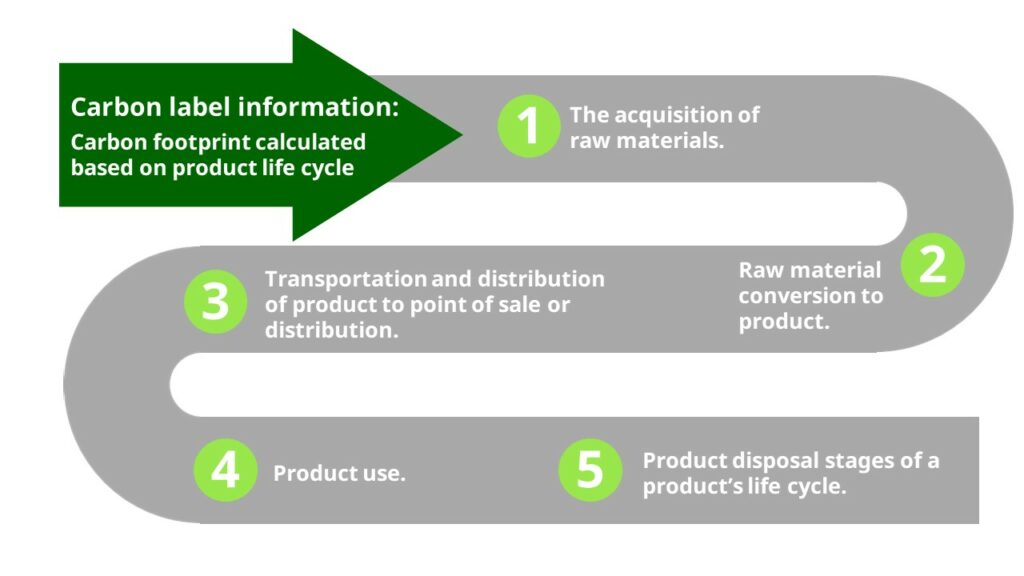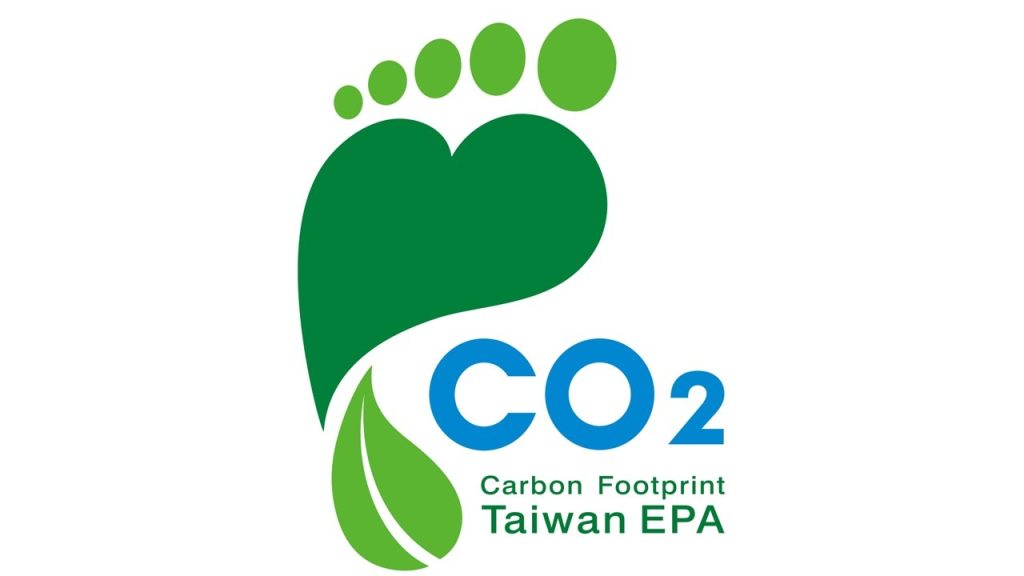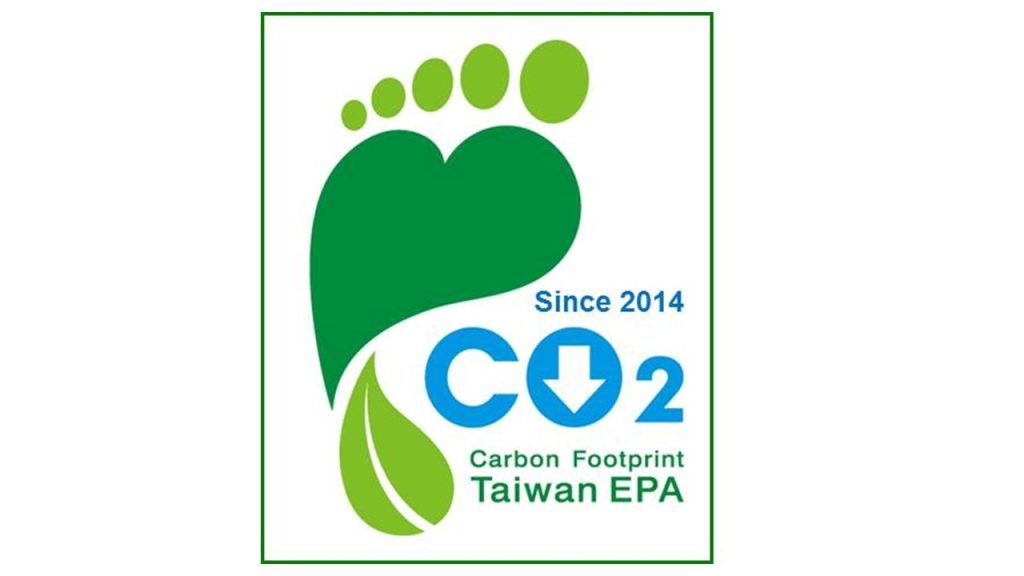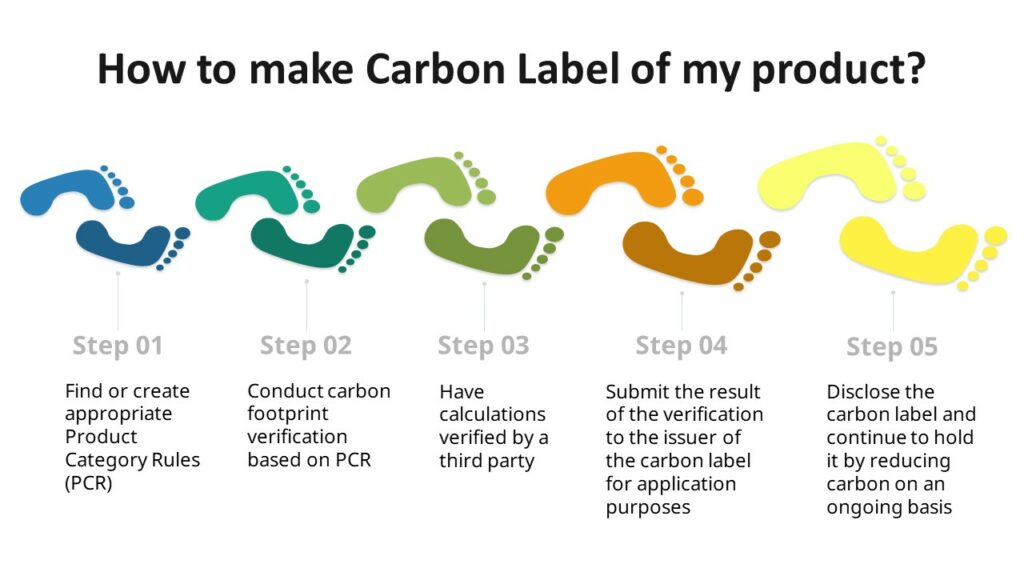
Greenhouse gas emissions are generated from various everyday sources, including food and drink, clothing, building and transport. These behaviors can worsen the greenhouse effect. The carbon emissions generated from them can be disclosed using carbon labels in order to measure their effect on climate change. This article describes how carbon labels are applied in daily life and their application and outlook in the future.
The History of Carbon Label
The carbon label originates from the Carbon Reduction Label introduced by the Carbon Trust in 2006. It is an organization formed by the UK government in 2001 aiming to assist corporations, governments and financial institutions in decarbonisation (reduction of carbon dioxide emissions generated from work processes). Corporations may use carbon labels to communicate the summary of the product footprint to consumers.
The footprint indicated on the carbon label is calculated through the life cycle product carbon footprint measures. In either a B2B (Cradle to Gate) or B2C (Cradle to Grave) sales model, the life cycle is divided into five stages from raw material production and distribution, product manufacturing, distribution and retail, use-phase to disposal and recycling. The carbon emissions at each stage are calculated separately.
In addition to disclosing product footprint, the Carbon Trust introduced the first carbon label in the world called the Carbon Reduction Label. The manufacturers using this label are obligated to reduce the carbon emissions generated by the commodities attached with the label, or they may lose the right to use it. Carbon labels are further classified depending on their respective meanings. The most commonly seen carbon labels are listed below:
- The regular label that only discloses carbon footprint
- The carbon reduction label that indicates the reduction of carbon emissions relative to the products of the entity itself or similar mainstream products
- The carbon neutral label indicating that products or services have accomplish carbon neutrality through carbon offset
The carbon label that the Carbon Trust introduced in 2006 is applied to many best-selling products. For example, according to the calculations of Walkers, which owns various famous brands including Doritos and Lay’s, 34.5 grams of potato chips generate 80 grams of carbon emissions. The Corporation reduced 7% of carbon emissions during the period between 2007 and 2009 and thus acquired the right to use the carbon label. Many countries including Canada, Japan, Korea, France, Thailand, Australia and Taiwan also started the development and establishment of carbon label related regulations and issued the label to local corporations. Many organization and companies, such as Walmart and Timberland, develop and use their own carbon labels to disclose carbon footprint.

Carbon labels in different countries
The carbon label systems of the countries are different in some respects. Examples of these labels and their usage in different countries are described below:
Taiwan
The Environmental Protection Administration of Taiwan started the establishment of the carbon label mechanism in 2009. The footprint figures and the calculation unit must be indicated on the label. It is designed with the form of a foot comprised of a green heart-shaped icon and a green leaf. Companies are encouraged to analyze and disclose the carbon footprint of their products at each stage. For example, ASUS and ACER acquired the carbon label for their notebooks in 2010 and 2011, respectively. The government of Taiwan introduced the carbon footprint reduction label in 2014. The carbon footprint of the product for which the use of the label is approved must be reduced by more than 3% within five years. The products approved to use the carbon footprint reduction label include Coca Cola’s 2L plastic bottle and the transport service of the Taiwan High Speed Rail.

United States
The US Environmental Protection Agency has not established carbon label related regulations. The California state government is the only authority that has tried to set up a carbon label program in the US but ultimately failed to put into practice. Most American corporations use the carbon labels introduced by third-party or other overseas organizations such as the Carbon Trust. For example, Nestle, a leading coffee and cocoa products manufacturer, has their products certified by the Carbon Trust.
France
In France, the first proposal for the introduction of a carbon label system was raised in 2007. However, the government currently does not have its own official carbon label. The low carbon label (le Label bas-carbone) introduced by the Ministère de la Transition écologique is a certification for the project of carbon emission reduction through carbon offset, and has a different meaning from the carbon label described in this article. Nevertheless, the French Ecological Transition Agency (ADEME) is planning to apply the carbon label system widely to the food and textile industries from 2023.
The well-known French companies using carbon labels include Casino, a large retail group. It started using the carbon label “Groupe Casino Indice Carbon” at the end of 2008. By working with their suppliers, the label is applied to more than 3,000 products of the Group. The carbon emission intensity is graded quickly from 1 to 10 with green leaves and the emissions for every 100 grams are indicated on the label.
Japan
The Ministry of Economy, Trade and Industry of Japan, started drawing up carbon label regulations in 2009 and introduced the Carbon Footprint of Product (CFP) in 2012, authorizing its management to a private contractor. The label looks like a kitchen scale designed with the idea that the carbon dioxide is invisible but can spread indefinitely on the scale. In 2017, the Carbon Footprint of Product was combined into a JEMAI Environmental Label project, changing its name to SuMPO Environmental Label Program in 2022. The products for which the application for the carbon label is approved include the CITIZEN L-Series of CITIZEN WATCHES and the meat products of the Nippon Meat Packers Group (Nippon Meat Packers, Inc.)

How to use Carbon Label: What should I pay attention to?
The carbon label attached to a product or service represents the control of the carbon footprint. Consumers can clearly understand how much carbon is emitted in the entire consumption process and believe the manufacturer has a sense of responsibility on the issue of climate change.
Many carbon labels are only marked with the carbon emissions currently. Since not all products and services have carbon labels attached, consumers are not able to understand the relative amount of the carbon emissions directly. For example, a carbon footprint of 450 grams is indicated on the carbon label attached to the 600ml Coca Cola plastic bottle in Taiwan. However, consumers cannot make sure whether this carbon footprint is high or low because other cola companies, such as Pepsi, have not applied for the Taiwan carbon label for their brand products and the changes to the carbon footprint before Coca Cola applied for the carbon label is unknown.
In response to this issue, the amount of carbon emissions in the products of the same type is presented with a color or a scale on some carbon labels, such as theGroupe Casino Indice Carbon. The Carbon Trust and the the Environmental Protection Administration of Taiwan, for example, introduced another carbon reduction label. The products or services for which the application for this label is approved must meet the standard requiring that carbon emissions be reduced every year. Corporations may use this carbon label that discloses more information to communicate easily understandable carbon emission information to consumers.

Top 3 benefits of Carbon Label

Corporations
For corporations, attaching carbon labels to products means a calculation of their carbon footprint. They are helpful for companies to understand the greenhouse gas emissions generated at each life cycle stage of their products. When a corporation is going to implement decarbonisation, it can quickly improve the behaviors that generate a higher concentration of carbon emissions, and this is very helpful for its sustainable operations.
In addition, disclosing carbon emission information to consumers may also help achieve SDG 12 Responsible Consumption and Production and SDG 13 Climate Action. It can also help corporations fulfill their ESG obligations and improve their corporate image. According to the consumer study announced by Carbon Trust in 2020, more than two thirds of the interviewees stated that they have a good impression of the corporations that reduce their carbon footprints, and 23% of the interviewees said they will consider buying the products with relatively low carbon footprints.
Consumers
Carbon labels can help consumers understand the burden to the environment when they buy products or services, and thus have more awareness of the environmental impact and the morality of their purchases. To implement green initiatives in daily life, there should be explicit basis for the support of more environment-friendly products.
Environmental
Using carbon labels can help corporations check and reduce the carbon emissions during the life cycle of a product, improve the awareness of the environmental impact among consumers and reduce greenhouse gas emissions. Many researches have proved the benefits of carbon labels to the environment. For example, the researches of Betz A-K, Seger BT, Nieding G (2022). How can carbon labels and climate-friendly default options on restaurant menus contribute to the reduction of greenhouse gas emissions associated with dining? Paul M. Lohmann., Elisabeth Gsottbauer, Anya Doherty., Andreas Kontoleon. (2022). Do carbon footprint labels promote climatarian diets? Evidence from a large-scale field experiment. Journal of Environmental Economics and Management, Volume 114 points out that carbon labels can help reduce carbon emissions generated from diets.
How to make Carbon Label of my product?
The details of the application for individual carbon labels are somewhat different for organizations. The following are summarized principles and steps of application for carbon labels as well as related regulations and standards, effective period and other matters that corporations should note.

Step 1: Find or create appropriate Product Category Rules (PCR)
Since products or services are different within their life cycles, the Product Category Rules (RCP) are needed to define the scope of life cycle for each type of product to ensure comparability of the carbon footprint results. The most commonly used international PCR is the ISO 14025-based EPD-PCR. It is a PCR covering more than one hundred items and, in addition to greenhouse gas emissions, calculates various environmental impacts including acid rain, water eutrophication and the ozone layer. Some countries, such as Taiwan and Japan, have introduced domestically applicable PCR to regulate carbon emissions.
If the existing PCR does not cover the products or services of an organization, collaboration with other companies in the industry is needed to establish a new PCR. Experts should be invited for review purposes. The review committee members must be professionals of the governmental organizations, companies and research institutions specializing in life cycle assessment. For example, Renouvo, a manufacturer of environmentally-friendly materials in Taiwan, worked together with the industry and the Environmental Protection Administration of Taiwan to establish the PCR for “plant fiber tableware” and provide regulations for the life cycle assessment of sugarcane straws, wheat dinner plates and other plant fiber dining utensils when calculating carbon footprints.
Step 2: Conduct carbon footprint verification based on PCR
With the PCR as the basis for the carbon footprint verification, corporations can start to calculate the amount of the carbon emissions at five stages from raw material production and distribution, product manufacturing, distribution and retail, use-phase to disposal and recycling. The calculations include vehicles and transport, lighting equipment, household waste generated by the employees, and other factors. The results show the share of carbon emissions at each stage of the life cycle and the amount of carbon emissions generated by each product or service.
Step 3: Have calculations verified by a third party
After the carbon footprint of a product or service is acquired, corporations authorize a third-party institution recognized by a carbon label certification body for verification of its reliability. The most common international third-party institutions include BSI, TUV Rheinland and SGS. The verification may also be conducted by the issuer of the carbon label, usually pursuant to the ISO 14067, PAS 2050 or GHG Protocol Product Standard.
Step 4: Submit the result of the verification to the issuer of the carbon label for application purposes
After validating the result of the carbon footprint verification, corporations submit it to the issuer of the carbon label to acquire the right to use it. Some carbon labels are subject to additional regulations. In addition to the calculation of the carbon footprint, corporations must give their commitments to carbon reduction to acquire the carbon labels issued in Taiwan and by the UK Carbon Trust. Neither issuer recognizes carbon offset as a means for the reduction of emissions.
Step 5: Disclose the carbon label and continue to hold it by reducing carbon on an ongoing basis
After acquiring the carbon label, corporations may disclose it to the consumer by redesigning packaging or announcing it in the form of a document on an official website, further improving their corporate image. Carbon footprints must be reduced continuously. Most carbon labels have an effective period. For example, the carbon label issued in Taiwan has an effective period of 3 years while the Japanese carbon label and that issued by the Carbon Trust are effective up to 5 and 2 years, respectively. After expiration of this period, an application with the new carbon footprint data must be filed again and the renewed carbon label cannot be acquired if the commitments to carbon reduction are not delivered.
Summary
Since carbon labels were first issued in 2007, disclosures have been increased from the simple carbon footprint information to the presentation of the carbon emission intensity, carbon reduction effectiveness, and even carbon neutrality. Using carbon labels for products or services may help corporations fulfill ESG obligations, improve corporate image, work with consumers to achieve SDG 12 Responsible Production and Consumption, and mitigate the problem of climate change.
Corporations may calculate their carbon footprint pursuant to PAS 2050 or ISO 14067 standards, acquire the carbon label after passing third-party certification, and deliver their carbon reduction commitments to keep their leading position in the decarbonisation of the industry and cope with the new regulations of the France and EU that may require a compulsory disclosure of the carbon footprints.